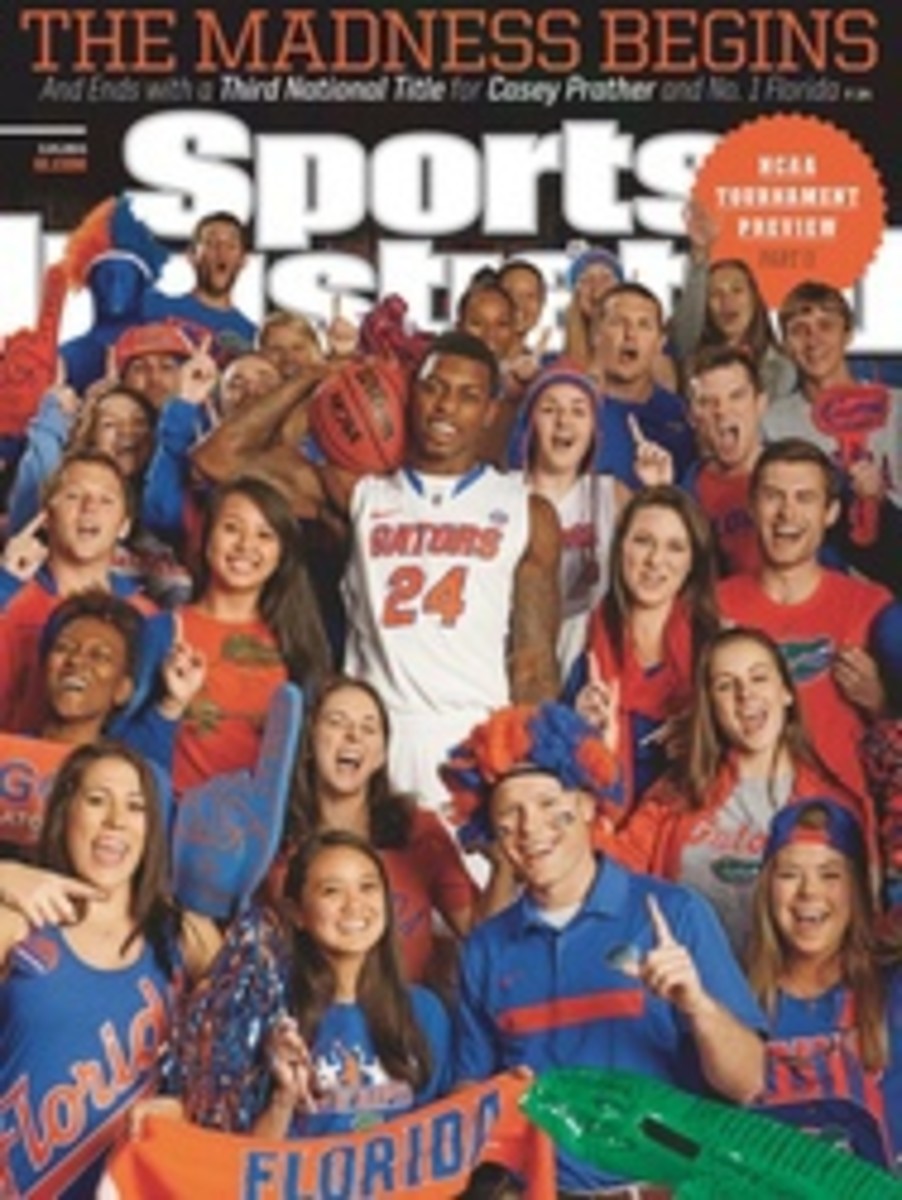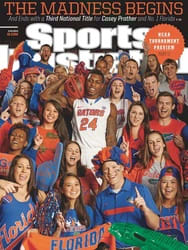
Orange Blossom
JUST AS every branch of Jerami Grant's family tree grew tall and long, each basketball-playing member also bloomed late. Grant's dad, Harvey, and Harvey's identical twin, Horace, spent a combined 28 years in NBA frontcourts. But in high school they were sleeper recruits from a three-stoplight Georgia town who chose Clemson over Grambling. Jerami's older brothers, 6'8" Jerai (Clemson) and 6'5" Jerian (Notre Dame), earned scholarships, but their games didn't fully develop until late in their college careers. Jaelin is a 6'7" junior at Washington, D.C.--area power DeMatha Catholic and destined for Division I, but he didn't start this season.
Jerami's breakout season at Syracuse happened only after his shot underwent reconstructive surgery. While the 6'8" sophomore forward is best known for his rim-strangling put-back dunks, he tripled his scoring average (3.9 to 12.2) by adding a midrange game. "I think he's just going to be a monster one day," says Orange coach Jim Boeheim. "He's a late-developing monster."
When that monster fully arrives, Grant can thank old-fashioned player development, something overlooked in the straight-to-Vines culture. While Kansas freshman Andrew Wiggins's upside draws more attention than Creighton senior Doug McDermott's up-and-unders, an appreciation of incremental improvement is getting lost. "In high school, Jerami was labeled a slasher," says Villanova coach Jay Wright. "That's a kind way of saying a guy is a good athlete and can't shoot."
Assistant coach Adrian Autry served as lead surgeon on Grant's jumper. When he first arrived on campus, his right elbow jutted out like a chicken wing and the ball spun sideways out of his hand. Autry started with the most basic instruction, squaring Grant's feet, moving the ball off his palm to his fingertips and repositioning his thumb. Grant didn't resist, even though for a player, changing shooting style is like changing identity. "Intimidating," says Grant, "is the right word."
Once his basic form was correct, Grant learned to caress the ball with his off hand—instead of smacking it—to ensure proper rotation. His shooting has improved slightly from the field (46.2% to 48.3%) and drastically from the free throw line (56.2% to 66.9%). Grant says he arrived at Syracuse a "one-eyed" shooter, meaning that at the point of release, the ball obscured his right eye's view of the rim. His sightline cleared, and his mind remained open. "A lot of times you work on a move with a kid but you never really see it," Autry says. "With Jerami, if he believes it, then he'll become it."
HARVEY AND Beverly Grant's sons—Harvey Jerai, Holdyn Jerian, Houston Jerami and Harrison Jaelin—inherited their father's height. (Harvey is 6'8"; Beverly, 5'9".) Growing up, Jerai, now 25, tormented Jerian; Beverly recalls tears during every trip home from the gym. Jerian, 21, became a shooter—how else could he score over his brother?—and, in turn, took out his frustrations on Jerami, 20. Their lunchtime dustups as preteens are DeMatha summer camp lore. "It was always game point when the fight broke out," says DeMatha coach Mike Jones. "Neither of them wanted to lose, so if one was getting ready to win, the other would foul the crap out of him. Every time."
All the Grant kids attended DeMatha, with Beverly shuttling them from their home in Bowie, Md., to Hyattsville in a white GMC conversion van. (The couple divorced in 2010.) The first three Grants won multiple city championships, with Jerai part of three title teams and both Jerian and Jerami winning two.
Jerai, a stringy 230-pound low post player, finally put it all together his senior year at Clemson (2010--11) when he scored 12.4 points per game. He plays in Latvia for BK Ventspils. As a fourth-year junior, Jerian was averaging 19.0 points through 12 games this season when he committed an academic violation and was forced to leave school. The Irish tanked after his departure, finishing their inaugural ACC season 15--17. Jerian plans to return to South Bend in June.
Jaelin has been the slowest to develop, but schools such as Florida Gulf Coast, UMass, Temple and George Washington are interested despite his modest statistics (2.5 ppg). Those coaches have studied the bloodlines. "Jaelin's best basketball," says Jones, citing a familiar family refrain, "is ahead of him."
EVEN AS Jerami's game has improved, his father still second-guesses his son's fashion choices. "Pink skinny jeans?" grumbles Harvey. Jerami's wardrobe includes gray skinny sweatpants with patches of black leather, Pink Dolphin shirts and SpongeBob socks. But only his clothing is loud. "He doesn't say boo," Boeheim insists. "We have a team of mutes. You won't hear hardly a word in our practice."
As a freshman, Grant quietly accepted the same role that Fab Melo, Dion Waiters and Michael Carter-Williams once had: Orange sub. Each became a star in his second season, then went in the first round of the NBA draft. Grant never complained about not starting, instead channeling his energy into his workouts with Autry. Every day after practice Grant makes between 200 and 300 shots, with Autry's voice providing the sound track.
Keep in line. Steady diet. Love the line. (That is, the arc of the shot.)
Boeheim & Co. glimpsed Grant's potential when senior forward James Southerland was suspended for six games during Big East play last season. Grant averaged 33.2 minutes during that stretch and put up 13- and 12-point games against Villanova, showing Wright he could do more than slash. This season Grant cracked the starting lineup only when a knee injury sidelined 6'9" power forward DaJuan Coleman in January. And Grant is still only Syracuse's fourth option on offense. "I bust [Autry] all the time," says Keith Stevens, who coached Grant on grass-roots basketball power Team Takeover. "How many players in America can you get to do the stuff he's doing, and you don't have to run a play for him?"
Grant's best performance came in an epic 91--89 overtime win over Duke on Feb. 1, when he scored 24 points, pulled down a game-high 12 rebounds, crushed home three dunks over Andre Dawkins in OT and, most impressive, went 10 of 10 from the foul line. "It was great to know all the hard work has been paying off," he says. Since mid-February, back spasms have limited his playing time and contributed to the Orange's slump; after starting 25--0 they lost four of six games to end the regular season. But Grant had 16 points and eight boards in the 74--58 win at Florida State on March 9—his first full game since Feb. 22—and hopes to remain healthy for March Madness.
That could also mean the end of his run at Syracuse. Just as Carter-Williams used his tournament play in 2013 as a springboard to the NBA after his sophomore season—the 76ers' point guard, drafted 11th, is the front-runner for the Rookie of the Year award—so could Grant. Five NBA executives polled by SI said that Grant would be selected between the 15th and 25th picks, giving Syracuse a third potential first-rounder to go with freshman point guard Tyler Ennis and senior forward C.J. Fair. Boeheim projects Grant to be a 15-year NBA player, but thinks he needs to build up from 218 pounds to at least 230 to compete at power forward. "Jerami is not physically ready," Boeheim says. "You've got to go when you're ready. It's a shame we're in a culture where you've got to go right now. There's nothing wrong, even for a really good player, to develop."
Grant's drives to the basket can still be an adventure, as his lanky body gives him the look of a giraffe on roller skates. His range needs to expand; he hasn't hit a three-pointer this season in five tries. The late lottery is filled with cautionary tales, and one executive says that if Grant leaves this year, he'd likely spend some time in the D-League. Harvey believes his son will do what's best to build the foundation for a long career. Getting drafted, says Harvey, "is the easy part."
In the Grant family that may actually be the case. The third son with the once-rickety jump shot is on his way, developing at the methodical pace that's become family tradition.
Nigel Hayes, 6'7" freshman PF, Wisconsin
After a two-point, four-foul debut against St. John's on Nov. 8, the top 100 recruit from Whitmer High in Toledo made a confession to the media: He'd been nervous. That candidness—talking about coach Bo Ryan's inability to play Call of Duty on a recruiting visit, saying he stole his Chocolate Tornado inside pivot move from Shaq—has made the 6'7", 250-pound freshman a big hit in Madison. Even more appealing is Hayes's smooth midrange jumper: He has averaged 10.2 points on 54.1% shooting since the beginning of February. When the Badgers entered a late-January swoon, it was the conference's sixth man of the year who helped revive their offense. In March, opponents will be the ones worrying.
54.6
Hayes's FG% in Big Ten play, third in the conference.
Malcolm Brogdon, 6'5" sophomore SG, Virginia
Sidelined last season while recovering from a broken left foot, Brogdon was hardly inactive. The 6'5" sophomore worked on his dribbling and shooting while hobbling around on one foot and became a film critic, scrupulously dissecting footage from his promising-but-flawed first campaign. With an altered release point to add arc to his shot—not to mention a newfound ability to take care of the ball—Brogdon was the driving force behind the Cavaliers' surprising seizure of the ACC title, averaging a team-best 14.8 points in conference play while connecting on 41.5% of threes. His break, it turns out, wasn't so bad after all.
18
Brogdon's double-digit scoring games in ACC regular-season play.
PHOTO
RICH BARNES/USA TODAY SPORTS
PHOTO
MIKE MCGINNIS/GETTY IMAGES
PHOTO
SCOTT CUNNINGHAM/GETTY IMAGES (BROGDON)
PHOTO
ANDREW D. BERNSTEIN/NBAE/GETTY IMAGES (HARVEY GRANT)
HOOP DREAMS Harvey (far left), who averaged 9.9 points and 4.4 rebounds during 11 NBA seasons, has helped guide the basketball careers of his four sons.

